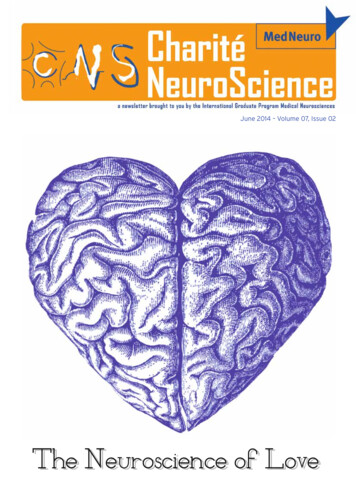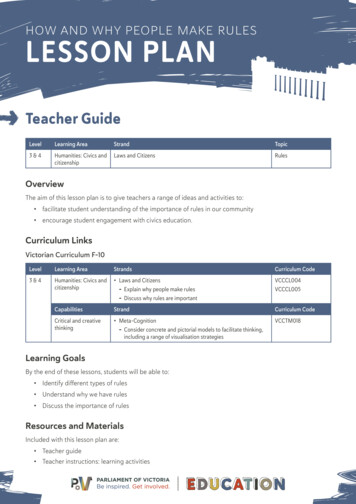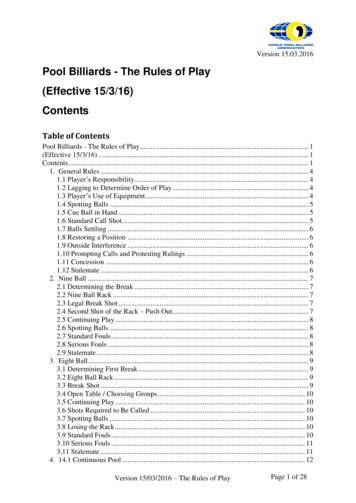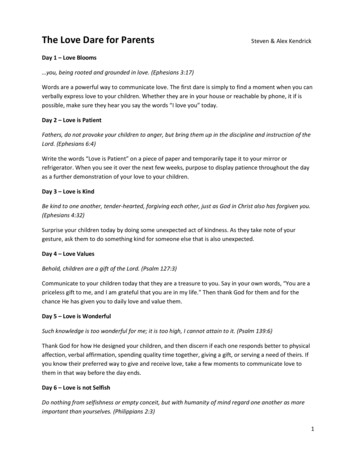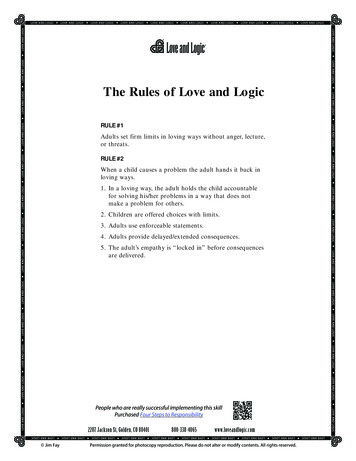
Transcription
LOVE AND LOGIC LOVE AND LOGIC LOVE AND LOGIC LOVE AND LOGIC LOVE AND LOGIC LOVE AND LOGIC LOVE AND LOGIC LOVE AND LOGIC LOVE AND LOGIC LOVE AND LOGICThe Rules of Love and LogicRULE #1Adults set firm limits in loving ways without anger, lecture,or threats.RULE #2When a child causes a problem the adult hands it back inloving ways.1. In a loving way, the adult holds the child accountablefor solving his/her problems in a way that does notmake a problem for others.2. Children are offered choices with limits.3. Adults use enforceable statements.4. Adults provide delayed/extended consequences.5. The adult’s empathy is “locked in” before consequencesare delivered.People who are really successful implementing this skillPurchased Four Steps to Responsibility2207 Jackson St, Golden, CO 80401 Jim Fay800-338-4065www.loveandlogic.comPermission granted for photocopy reproduction. Please do not alter or modify contents. All rights reserved.
CREATING YOUR SCHOOL’S CORE BELIEFSWhen working with students in a disciplinary situation:Choose 5-7 of these to create a set of core beliefs for your school. This is your code of ethics or promiseto students and parents about the treatment of disciplinary situations.1. I believe that every attempt should be made to maintain the dignity of both the adult and thestudent.2. I believe that students should know that misbehavior makes adults angry.3. I believe that students should know that misbehavior results in loss of privileges.4. I believe that adults should be respected because they are the adults.5. I believe that students should be guided and expected to solve the problems they create withoutmaking problems for anyone else.6. I believe that students should expect rewards for good behavior.7. I believe that students should be given the opportunity to make decisions and live with the results,whether the consequences are good or bad.8. I believe that misbehavior should be handled with natural consequences instead of punishmentswhenever possible.9. I believe that students should know that the adults are the bosses and in control at all times.10. I believe that students should have the opportunity to tell their side of the story (due processhearing) when consequences appear to be unfair.11. I believe that teachers are responsible for raising student self-esteem.12. I believe that school problems should be handled by school personnel and that criminal activityshould be referred to the proper authorities.13. I believe that misbehavior should be viewed as an opportunity for individual problem solving andpreparation for the real world as opposed to a personal attack on the school or staff.14. I believe that students should pay for repeat misbehaviors.15. I believe that it is best if a student does most of the thinking.16. I believe that there should be a logical connection between misbehavior and resultingconsequences.17. I believe that it is the administrator’s job to make students behave so that teachers can teach.18. I believe that parents should punish their children when they misbehave at school.19. I believe that prescribed punishments for rules infractions are an important part of maintainingdiscipline.20. I believe that every student and every rules infraction should be treated the same way. Jim Fay, Love and Logic Institute Inc., 2207 Jackson St., Golden, CO 80401Permission granted for photocopy reproduction. Please do not alter or modify
LOVE AND LOGIC LOVE AND LOGIC LOVE AND LOGIC LOVE AND LOGIC LOVE AND LOGIC LOVE AND LOGIC LOVE AND LOGIC LOVE AND LOGIC LOVE AND LOGIC LOVE AND LOGICThe Delayed or “Anticipatory” ConsequenceImmediate consequences work really well withrats, pigeons, mice, and monkeys. In real-worldclassrooms, they typically create more problemsthan they solve.Problems with Immediate Consequences:1.Most of us have great difficulty thinking of animmediate consequence while we are teaching.2.We “own” the problem rather than handing itback to the child. In other words, we are forced todo more thinking than the child.3.We are forced to react while we and the childare upset.4.We don’t have time to anticipate how the child,his/her parents, our administrators, and otherswill react to our response.5.We don’t have time to put together a reasonableplan and a support team to help us carry it out.6.We often end up making threats we can’t back up.7.We generally fail to deliver a strong dose ofempathy before providing the consequences.8.Every day we live in fear that some kid will dosomething that we won’t know how to handlewith an immediate consequence.Take care of yourself, and give yourself abreak! Here’s how:The next time a student does something inappropriate,experiment with saying, “Oh no. This is so sad. I’m going to have to do something about this! But not now later. Try not to worry about it.”The Love and Logic Anticipatory Consequence allowsyou time to “anticipate” whose support you mightneed, how the child might try to react, and how tomake sure that you can actually follow through witha logical consequence. This Love and Logic techniquealso allows the child to “anticipate” or worry about awide array of possible consequences.The Love and Logic Anticipatory Consequence techniquegains its power from this basic principle of conditioning.When one stimulus consistently predicts a second, thefirst stimulus gains the same emotional properties as thesecond. Stated simply: When “try not to worry about it”consistently predicts something the child really mustworry about, “try not to worry about it” becomes a consequence in and of itself an “Anticipatory” Consequence.People who are really successful implementing this skillPurchased The Love and Logic Classroom2207 Jackson St, Golden, CO 80401 Jim Fay800-338-4065www.loveandlogic.comPermission granted for photocopy reproduction. Please do not alter or modify contents. All rights reserved.
LOVE AND LOGIC LOVE AND LOGIC LOVE AND LOGIC LOVE AND LOGIC LOVE AND LOGIC LOVE AND LOGIC LOVE AND LOGIC LOVE AND LOGIC LOVE AND LOGIC LOVE AND LOGICHow To Create A Love And Logic Classroom1.The following tapes and books are excellent for the purpose of learning the Love and Logicphilosophy and techniques:a.Teaching With Love and Logicb.Quick and Easy Classroom Interventionsc.Creating a Love and Logic School Cultured.Calming the Chaos: Behavior Improvement Strategies for the Child With ADHD2.Most people benefit from reviewing these Love and Logic materials several times. This “over-learning” willenable you to more readily apply these Love and Logic techniques while teaching.3.Start slow. Pick just one Love and Logic technique and begin to experiment. Here are some examples tochose from:a.Neutralizing arguing with the Brain Dead techniqueb.Locking-in sadness or empathy before delivering consequencesc.Setting limits with enforceable statementsd.Sharing control through lots of small choicese.Building relationships with the One Sentence Interventionf.The Anticipatory Consequence4.One-by-one, start experimenting with additional Love and Logic techniques.5.Call the Love and Logic Institute at 1-800-338-4065, and ask for a copy of the Creating Your School’s CoreBeliefs worksheet. There is no charge for this. Choose between five and seven of these principles to guide yourdisciplinary decisions. Feel free to modify or add principles as long as each is consistent with Love and Logic.In your classroom, post a list of expectations, describing how you will run your classroom. When developingthis list, be certain that you can actually enforce these expectations. In other words, avoid making threatsthat you cannot back-up, such as “Keep your hands to yourself” or “Be quiet when I’m teaching.” Use whatwe term “Enforceable Statements” to set these Love and Logic limits and expectations in your classroom.6.7.DO NOT WARN STUDENTS ABOUT SPECIFIC CONSEQUENCES IN ADVANCE!Just indicate that you will respond to each problem in an individualized manner, depending upon theunique situation.Purchased Teaching with Love and Logic2207 Jackson St, Golden, CO 80401 Jim Fay800-338-4065www.loveandlogic.comPermission granted for photocopy reproduction. Please do not alter or modify contents. All rights reserved.
LOVE AND LOGIC LOVE AND LOGIC LOVE AND LOGIC LOVE AND LOGIC LOVE AND LOGIC LOVE AND LOGIC LOVE AND LOGIC LOVE AND LOGIC LOVE AND LOGIC LOVE AND LOGICHow To Create A Love And Logic ClassroomHere are two examples of Love and Logic lists:Classroom Expectations (Example #1)1.Feel free to do anything that does not cause a problem for anyone else.2.I teach when there are no distractions or other problems.3.I listen to students who raise their hand.4.I listen to one person at a time.5.Please treat me with the same respect I treat you.6.If someone causes a problem, I will do something.7.What I do will depend on what happened and what the person is willing to do to solve the problem.Classroom Expectations (Example #2)1.I allow students to remain in my classroom as long as they do not cause a problem for anyone else.2.If they cause a problem, I will ask them to fix it.3.If they can’t or will not fix it, I will do something.4.What I do will depend on the unique situation.8.When making disciplinary decisions, ask yourself, “How is my proposed intervention consistent with myCore Beliefs of discipline that I have included in my plan and my posted list of expectations?” Encourageyourself to handle discipline problems on a case-by-case manner, focusing on the unique characteristicsof each situation.9.If you don’t know what to do at any given moment, delay the consequence, refer to your plan, and discusspossible solutions with other teachers, your administrators, the child’s parents, or others.10. Your goal is to achieve consistency by basing each of your decisions on this same set of values orprinciples rather than trying to treat every problem the same using a “cookbook” approach. Consistencywith values is more attainable than consistency between students, situations, and consequences.Purchased Teaching with Love and Logic2207 Jackson St, Golden, CO 80401 Jim Fay800-338-4065www.loveandlogic.comPermission granted for photocopy reproduction. Please do not alter or modify contents. All rights reserved.
LOVE AND LOGIC LOVE AND LOGIC LOVE AND LOGIC LOVE AND LOGIC LOVE AND LOGIC LOVE AND LOGIC LOVE AND LOGIC LOVE AND LOGIC LOVE AND LOGIC LOVE AND LOGICAn Example Love And Logic Classroom Discipline PlanGuidelines and Code of Ethics for DisciplineMrs. Krochmal 1996-97Rules in my classroom are few. I believe that as all children are different, and all actions and reactions very personalin nature, effective discipline involves a few overriding tenets rather than a long list of specific rules. Situations aredealt with as they arise with the focus on enabling the child to grow and learn from his or her actions.Guidelines for Student Behavior1.You may engage in any behavior which does not create a problem for you or anyone else in the world.2.If you find yourself with a problem, you may solve it by any means which does not cause a problem foranyone else in the world.3.You may engage in any behavior that does not jeopardize the safety or learning of yourself or others.Unkind words and actions will not be tolerated.In ensuring that the above guidelines are adhered to, I will operate with the following principles as my guide:1.I will react without anger or haste to problem situations.2.I will provide consequences that are not punitive but that allow the child to experience the results of a poorchoice, enabling him or her to make better choices in the future.3.I will proceed in all situations with the best interest of the child who—foremost in my mind—academic,social and emotional well-being will be fostered.4.I will guide students toward personal responsibility and the decision-making skills they will need to functionin the real world.5.I will arrange consequences for problem situations in such a way that the child will not be humiliatedor demeaned.6.Equal is not always fair. Consequences will be designed to fit the problems of individual students, and theymay be different even when problems appear to be the same.7.I will make every effort to ensure that, in each situation, the students involved understand why they areinvolved in consequences.8.If I at any time act or react in a way that a child truly feels is unjust, that student need only say to me, “I’mnot sure that’s fair.” I will arrange a private conference during which the student can express to me why heor she feels my actions were not fair. This may or may not change my course of action. I am always opento calm, rational discussion of any matter.Purchased Teaching with Love and Logic2207 Jackson St, Golden, CO 80401 Jim Fay800-338-4065www.loveandlogic.comPermission granted for photocopy reproduction. Please do not alter or modify contents. All rights reserved.
LOVE AND LOGIC LOVE AND LOGIC LOVE AND LOGIC LOVE AND LOGIC LOVE AND LOGIC LOVE AND LOGIC LOVE AND LOGIC LOVE AND LOGIC LOVE AND LOGIC LOVE AND LOGICHow To Create A Love And Logic School1. Introduce the Love and Logic approach to your staff by doing one of thefollowing options:a.Have the staff listen to the first two stories on the audio CD Four Steps to Responsibility. Make the CDavailable to those who are interested.b.Play one of the video clips from the Love and Logic teacher training program, 9 Essential Skills for theLove and Logic Classroom.c.Invite a staff member from a Love and Logic school to make a presentation to your staff about the useof Love and Logic in their school.d.Invite a consultant from the Love and Logic Institute to make a presentation to the school or theschool district. For information on hiring Jim Fay or Dr. Charles Fay, phone 1-800-338-4065.2. Create a study group:a.DO NOT MANDATE LOVE AND LOGIC! This group should be made up of volunteers who are the mostenthusiastic about learning new ways of working with students.b.If possible, provide 1 hour of release time on a repeated basis for this select group to study the trainingprogram, 9 Essential Skills for the Love and Logic Classroom. These staff members conduct experimentswith the Love and Logic techniques and informally share their enthusiasm for the results. The bestresults come when the administrator is part of the study group.c.Create additional study groups as needed.d.Provide the same kind of study opportunities for support staff members.3. Develop a lending library of training materials:Visit with our Love and Logic customer service department for suggestions and ideas about the most efficientuse of your budget. Call toll free 1-800-338-4065.4. Create a building-wide Love and Logic philosophy of discipline:a.Develop an agreed-upon set of basic Love and Logic principals that serve as a guide for all disciplinaryinterventions. Here are some suggested steps in developing this philosophy:I.Provide each staff member with a copy of the sheet entitled, Creating Your School’s Core Beliefs,which can be obtained from the Love and Logic Institute.II.Ask each staff member to take some time to circle five or six of the Love and Logic values orprinciples they would be proud to endorse.III. Encourage faculty members to change the wording of these Core Beliefs if they feel a strong need.Purchased Teaching with Love and Logic2207 Jackson St, Golden, CO 80401 Jim Fay800-338-4065www.loveandlogic.comPermission granted for photocopy reproduction. Please do not alter or modify contents. All rights reserved.
LOVE AND LOGIC LOVE AND LOGIC LOVE AND LOGIC LOVE AND LOGIC LOVE AND LOGIC LOVE AND LOGIC LOVE AND LOGIC LOVE AND LOGIC LOVE AND LOGIC LOVE AND LOGICHow To Create A Love And Logic SchoolIV. Have grade-level meetings where members discuss the Core Beliefs they circled. Next, use thisdiscussion to develop an agreed-upon set of Core Beliefs representing the entire grade level. Listthese Love and Logic principles on paper.V.Conduct a meeting with teachers from all grade levels. Vote on the principles developed by eachgrade level to develop a school-wide list of Love and Logic principles.VI. Post these Love and Logic principles in every room of the school.VII. Share this Love and Logic document with parents and other community members, asking for theirsupport in helping the school meet this commitment.VIII. When developing Love and Logic disciplinary interventions, ask, “How is my proposed Love andLogic intervention consistent with our overall principles of discipline?”Note: This entire process may take up to six months. Don’t rush it. Let it evolve.Special Note: This entire process is useless if the administrators are unwilling or unable to monitor staffimplementation.b.Encourage each staff member to deal with discipline situations in their own unique ways based uponthe merits of the situation, provided that the actions taken by the adult are consistent with the postedLove and Logic principles of the School Wide Philosophy.5. Provide parenting with Love and Logic training for the community:a.Purchase the parent training program, Parenting the Love and Logic Way. This program has beendesigned to be used without prior training. It is very practical and easy to teach. Just follow the simplelesson plans.b.Make it available to parents of all age children.c.Consider the parents of preschool and kindergarten children as a target audience.Note: You will find that each parent who takes this course will be much more supportive of the school staff. Injust a few short years, you can have the entire community speaking the same language about raising kids andyour job will get a lot easier!Special Note: Many schools have found that is very easy to get Kindergarten parents to these classes. Theschool secretary is the important cog in this wheel. When parents sign up their children for Kindergarten, thesecretary says, “Here are two forms. One is to register for Kindergarten and the other is to register for theparenting class that all Kindergarten parents take. You may register for the fall class or the spring class. It’s yourchoice.”People who are really successful implementing this skillPurchased Teaching with Love and Logic2207 Jackson St, Golden, CO 80401 Jim Fay800-338-4065www.loveandlogic.comPermission granted for photocopy reproduction. Please do not alter or modify contents. All rights reserved.
People who are reallysuccessful implementing thisskill purchasedTeaching with Love and Logic Charles Fay, Ph.D.
LOVE AND LOGIC LOVE AND LOGIC LOVE AND LOGIC LOVE AND LOGIC LOVE AND LOGIC LOVE AND LOGIC LOVE AND LOGIC LOVE AND LOGIC LOVE AND LOGIC LOVE AND LOGICSpecial Reminders Regarding the Use of the “RecoveryProcess” for Disruptive Classroom StudentsThe “Recovery Process” is one of the nine skills found in the multimedia training program, 9 Essential Skills forthe Love and Logic Classroom. An in-depth study of this technique can be found on pages 29-40 in the9 Essential Skills for the Love and Logic Classroom workbook.We have found that the Recovery Processloses its effectiveness when used withstudents who are not doing their assignments. The Recovery Process is not designed to punish,but is used strictly to eliminate annoying or disruptivebehaviors.Reminders:Students who are uninvolved in their lessons, but notbothering others, should remain in the classroomas long as their behavior is not interfering with thelearning process. The fact that these students are notdoing their assignment does not mean that they arenot soaking up at least some of the teacher’s wisdom. The Recovery Process is strictly used to minimize astudent’s ability to interfere with learning and/orteaching.Unskilled teachers, or those who lack understandingof the brain’s role in learning, often fear that astudent’s lack of involvement in the lesson will rub offon others, causing them to not want to learn. Theseteachers hold to the belief that kids don’t want tolearn in the first place and must be forced to do so.However, offtask be-havior has far more to do withunfulfilled basic needs and personal problems than adesire not to learn. It is a rare kid who has a goal ofbecoming a failure.In the event that another student in the classroom asks,“Why do I have to do the assignment? He isn’t doingthe work. Why can’t I do the same thing?” the skilledteacher simply replies, “Maybe you can do the same The Recovery Process is not designed to force kids todo their assignments. The Recovery Process is not designed to cure kids ofemotional problems. A student should not get personal attention froman adult while in Recovery. This time should bedevoted to getting one’s self back together. Studentsshould get time with adults when doing what isright, not when misbehaving. Do not send work with the student to do duringRecovery. The attitude of the teacher should be: “You arewelcome to be with us for every good minute—thismeans every minute you are not making it difficultfor me to teach or for others to learn. You arewelcome to use “Recovery” to get yourself backtogether. We want you in the classroom, so returnjust as soon as you know that you can be herewithout bothering anyone else.”thing. All you need to do is bring a note from yourparents telling me that you don’t need to learnanything in my class-room, and I will consider it.”2207 Jackson St, Golden, CO 80401 Jim ssion granted for photocopy reproduction. Please do not alter or modify contents. All rights reserved.
LOVE AND LOGIC LOVE AND LOGIC LOVE AND LOGIC LOVE AND LOGIC LOVE AND LOGIC LOVE AND LOGIC LOVE AND LOGIC LOVE AND LOGIC LOVE AND LOGIC LOVE AND LOGICSpecial Reminders Regarding the Use of the “RecoveryProcess” for Disruptive Classroom StudentsEffective use of the other essential skills of the Love and Logic classroom usually reduces the need to applythe Recovery Process. Building positive relationships with difficult kids is absolutely essential. Kids whoare willing to annoy the teacher are the ones who most desperately need to develop a positive relationshipwith that teacher. For this you will want to implement the essential skill, “The One Sentence Intervention.”This skill can be found in 9 Essential Skills for the Love and Logic Classroom. It is also presented inTeaching with Love and Logic.Note: It is wise to build the Recovery Process into theBehavior Support Plan for special education students.Until such time, give this child the opportunity to takework with him/her if the child so desires. (Children usually don’t beg to take work with them.)It is not uncommon for kids who carry a heavy loadof personal, family, and emotional problems to needseveral trips to a Recovery setting each day. This is anindication of a strong need for counseling or therapy.These kids are best reached by building a positive relationship with them, not in trying to overpower them.The true test of whether or not the Recovery Processis working resides in answers to these questions: “Canthe teacher teach while the student is in Recovery?”and “Can others learn without disruption while thestudent is in Recovery?” If the answer to both of thesequestions is yes, then the process is working. Don’texpect the Recovery Process to cure the problems behind misbehavior or lack of motivation.This attitude differentiates Recovery from “Timeout.”The Time-out process allows the teacher to decidewhen the student can return. The Recovery Process allows the student to decide when to return. However, ifthe student returns with a bad attitude, he/she shouldbe sent back to Recovery to do a better job of repairinghis/her attitude.When sending a student to Recovery, be sure to say,“You get back here just as soon as you can. We wantyou back with us.” Consistently making this statementcan eliminate a source of problem with parents whomight accuse the teacher of denying their child an education by excluding him/her from the classroom.People who are really successful implementing this skill purchasedHome and School Stratagies for Creating Respectful, Responsible Kids2207 Jackson St, Golden, CO 80401 Jim Fay800-338-4065www.loveandlogic.comPermission granted for photocopy reproduction. Please do not alter or modify contents. All rights reserved.
LOVE AND LOGIC LOVE AND LOGIC LOVE AND LOGIC LOVE AND LOGIC LOVE AND LOGIC LOVE AND LOGIC LOVE AND LOGIC LOVE AND LOGIC LOVE AND LOGIC LOVE AND LOGICTurn Your Word Into GoldThe Art of Enforceable Statements for the SchoolIneffective TechniqueLove and Logic TechniquePlease sit down. I’m going to start now.I’ll begin as soon as you are seated.Please be quiet. It’s time to begin.I’ll be glad to start as soon as you show me that youare ready.Open your books to page 54.I’ll be working from page 54.I’m not going to line you up until everyone is quiet.I’ll be lining people up as soon as it is quiet.Don’t sharpen your pencil while I’m talking.I allow people to sharpen pencils when I am notgiving directions.You can’t go to the restroom until I finish thedirections.Feel free to go to the restroom when I’m not givingdirections.Don’t be bothering your neighbors.You are welcome to stay with us as long as you andothers are not being bothered.Keep your hands to yourself.Feel free to stay with us when you can keep yourhands to yourself.Turn your assignment in on time or you’ll geta lower grade.I give full credit for papers turned in on time.Don’t talk to me in that tone of voice!I’ll listen as soon as your voice is as calm as mine.You show some respect.I’ll be glad to discuss this when respect is shown.Don’t be late for class.All of those who arrive on time go home on time.Don’t try to turn in sloppy papers to me.I’ll be glad to accept all papers that meet the neatnessstandard for this room.continued.2207 Jackson St, Golden, CO 80401 Jim Fay800-338-4065www.loveandlogic.comPermission granted for photocopy reproduction. Please do not alter or modify contents. All rights reserved.
LOVE AND LOGIC LOVE AND LOGIC LOVE AND LOGIC LOVE AND LOGIC LOVE AND LOGIC LOVE AND LOGIC LOVE AND LOGIC LOVE AND LOGIC LOVE AND LOGIC LOVE AND LOGICTurn Your Word Into GoldThe Art of Enforceable Statements for the SchoolIneffective TechniqueLove and Logic TechniqueKeep your desks organized and neat.All owners of neat desks are welcome to join us at recess.I’m not loaning you any more paper.I loan paper to those who have not borrowed before.If you can’t remember your pencil, you’re justgoing to have to do without.Feel free to borrow from anyone but me.You’re not going out without your coat.You may go out as soon as you have your coat.You’re not going to stay in this group and act like that.You may stay with us if you can give up on that behavior.Don’t you come back to this room until you canshow some respect!Feel free to come back to the room as soon as youare calm.Quit breaking the rules of the game.Those who can follow the rules are welcome to playthe game.Stop arguing with me.I’ll be glad to discuss this with you as soon as thearguing stops.If you can’t treat the paintbrushes right, you’ll justhave to sit out this project.All of those who can handle the paintbrushes rightare welcome to join us in the project.If you forget your permission slip, you're gong tomiss the trip.All of those who remember permission slips arewelcome to go on the field trip.People who are really successful implementing this skillPurchased Teaching with Love and Logic2207 Jackson St, Golden, CO 80401 Jim Fay800-338-4065www.loveandlogic.comPermission granted for photocopy reproduction. Please do not alter or modify contents. All rights reserved.
LOVE AND LOGIC LOVE AND LOGIC LOVE AND LOGIC LOVE AND LOGIC LOVE AND LOGIC LOVE AND LOGIC LOVE AND LOGIC LOVE AND LOGIC LOVE AND LOGIC LOVE AND LOGICTwo Ways to Neutralize Childhood Arguing1. LOVE AND LOGIC INSTANTEMPATHETIC RESPONSE2. LOVE AND LOGIC ONE-LINERS TONEUTRALIZE ARGUINGThe expression of genuine empathy hasthe amazing ability to soak up emotions.It is important that Love and Logic OneLiners be used in the “broken record” form.Learn to use an empathetic statementthat comes right from your heart. Use thestatement that feels natural to you. Useit every time.Example of a Love and Logic One-Linerthat should become a habit for you:“I love you too much to argue.”Examples of empathetic statementsthat work:Sample dialogue:“Oh, no. I bet that feels terrible.”“Wow. What a bummer.”PARENT: I love you too much to argueabout that.“I can’t imagine how bad that feels.”CHILD:Examples of statements that don’t work:“I know how you feel.”PARENT: I love you too much to argueabout that.“I know just what you mean.”CHILD:CHILD:“I understand.”You never let me do what I want.But Sally always gets to do whatshe wants.Yeah, that’s cause you likeher better.PARENT: I love you too much to argueabout that. Come talk to me laterabout something fun. See you,sweetie. Thanks.People who are really successful implementing this skillPurchased Four Steps to Responsibility2207 Jackson St, Golden, CO 80401 Jim Fay800-338-4065www.loveandlogic.comPermission granted for photocopy reproduction. Please do not alter or modify contents. All rights reserved.
Adults set firm limits in loving ways without anger, lecture, or threats. RULE #2 When a child causes a problem the adult hands it back in loving ways. 1. In a loving way, the adult holds the child accountable for solving his/her problems in a way that does not make a problem for others. 2. Children are offered choices with limits. 3.




